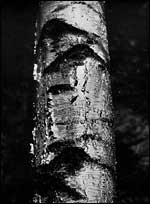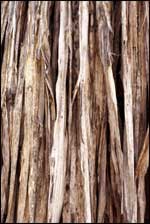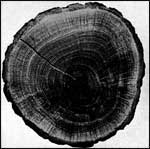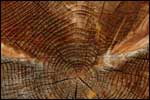Tree Bark
Trees, like knights of old, wear armor to protect themselves from injury. However, a tree's armor, called bark, is not made of heavy metal. Its outer layer, which we see, is composed of dead cells that become filled with a corklike substance and air. The inner bark, called Phloem, contains living cells and transports food from the leaves to other parts of the tree, including the roots. When these short-lived inner bark cells die, they become a part of the outer bark.

Bark serves as a waterproof overcoat for the tree, helps prevent loss of water from the tree by evaporation, acts as a barrier against attacks by insects and diseases, insulates the tree from drastic temperature changes, and in some instances, protects the tree from fire damage. It also serves as a shield to protect a very important part of the tree—the cambium layer. This layer of cells, which can be seen only with the aid of a microscope, manufactures both the inner bark cells and the sapwood cells. It produces a completely new layer of sapwood and bar tissue every growing season.
Thickness of the bark varies with the different tree species. In some, such as the madrone, the protective armor is quite thin, but in others it can be very thick. For example, the bark on a few of the giant sequoia trees in the Sierra Nevada Mountains is two feet thick.
As the growing tree expands by adding a new sapwood layer, its protective armor becomes too tight, and the outer bark splits and cracks. Definite bark patterns are produced by each species as a result of this cracking, and these patterns are so distinct that some trees can be identified by them. The outer bark layers also are shed in many different ways. Birth bark peels off in paper-thin strips; sycamore bark flakes off in large, thin, brittle plates; cedar bark peels off in long, fibrous strips; and the cinnamon-red plates of the ponderosa pine flake off in bits like jigsaw puzzle pieces that sometimes take shapes of fanciful animals—little dogs, owls, long-necked horses, and others.

In addition to its importance to the tree, bark also is of economic importance to man. From it he gets dyes, cork; cinnamon; drugs such as quinine, aspirin, and laxatives; and tannin, a chemical used for tanning leather. Bark is also used as a soil mulch or conditioner, but its primary use in these times of energy shortages is as a fuel source. Natural dyes can be obtained from the osage orange, black oak, black walnut, butternut, sumac, yellowwood, mesquite, red gum, and dogwood, but most of these natura dyes have been replaced in modern times with synthetic ones. Such was not the case in the days of the Indians and the early settlers.
All bark contains some cork, but a few trees, such as the cork oak, produce enough of this substance to make it economical to harvest. To obtain the cork, it is not necessary for the tree to be cut down. The dead bark can be stripped from the tree without harming it as long as the stripping is done carefully so the living inner bark is not damaged, and if it is done at intervals of at least ten years. The first stripping, which takes place when the tree is twenty years old, produces poor-quality cork. The second stripping, ten years later, produces better cork, but high-grade cork is not produced until the tree is at least fifty years old. These trees continue to bear cork for two hundred years, and the quality improves after each ten-year stripping until it reaches its peak. Imported cork oaks grow in California, but the oldest and most productive trees are native to the western Mediterranean Sea area.

An oil in the young bark of an evergreen tree native to Sri Lanka (formerly Ceylon) produces the spicy cinnamon flavor. The bark is peeled from the young twigs, tightly rolled, and dried to produce the cinnamon sticks often used to season hot party drinks. Powdered cinnamon, which you may sprinkle on your toast or eat on breakfast rolls, is merely ground bark from this tree.
Now that you are more aware of tree bark and its unique differences, perhaps you would like to start a collection of some different patterns. To do this, you do not need to collect the actual bark or damage the tree in any way; simply make a plaster cast of the bark patterns.
First take a piece of modeling clay and press it against the tree trunk. Soundly pat the back of the clay to force it into the bark ridges. Then carefully peel it from the tree, being sur not to stretch or break it. The texture of the bark pattern will be imprinted into the clay. If the impression is not to your liking, rework the clay and try again. When you get an impression that pleases you, place the clay, impression side up, in a small shoebox, foil pie pan, or other such container and pour a plaster of paris mixture over it to a depth of one-half inch or more. The plaster should have the consistency of pancake batter or a thick malt. When the plaster has thoroughly hardened, remove it from the container.

Trim off any plaster that may have run under the clay so the entire clay surface is exposed. Use your fingers to dig as much of the modeling clay as possible out of the ridges of the plaster cast. Do not use a knife or other sharp object as they could damage the plaster pattern. (I have been told that spraying the clay with Pam before adding the plasture mixture will make the clay easier to remove; however, I have not tested it.) Any clay you cannot remove with your fingers can be scrubbed out with hot water and a small brush. Any tiny bits of clay that will not come out should be hidden when you apply a brown water-color coating to the bark portion of the finished plaster cast.
If making plaster casts
does not interest you, but
you would still like to
collect bark patterns, try
making rubbings of them.
Hold a piece of white paper
against the tree trunk and,
being careful not to allow
it to slip or shift positions,
rub over the paper with
the side of a crayon. A
pattern fro the bark will
appear on the paper. Of
course, the easiest way
to collect bark is with
the camera lens, as our
photographer has done.

Next time you visit a state park, walk the nature trails or wander around the camping areas and see how many different kinds of trees you can find. The following books may also help you to identify them and learn more about them:
- Knowing Your Trees, by G.H. Collingwood and Warren D. Brush, published by the American Forestry Association.
- Important Trees of Eastern Forests, by R.W. Neelands, published by the U.S. Forest Service.
- Forest Trees of Texas, Bulletin No. 20, published by the Texas Forest Service.
- The Secret Life of the Forest, by Richard M. Ketchum, produced in cooperation with the St. Regis Paper Company, published by American Heritage Press.
- A Pocket Guide to Trees, by Rutherford Platt, published by Pocket Books.
- Trees, Shrubs, and Woody Vines of the Southwest, by Robert A. Vines, published by the University of Texas Press.
Ilo
Hiller
1983 Tree Bark. Young
Naturalist. The Louise
Lindsey Merrick Texas Environment
Series, No. 6, pp. 82-85.
Texas A&M University
Press, College Station.